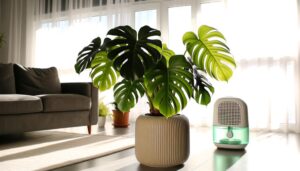Monstera Albo in Sphagnum Moss
Using sphagnum moss for your Monstera Albo offers several advantages. The moss excels at water retention and aeration, reducing risks of root rot and optimizing nutrient uptake.
Make sure you select high-quality moss, clean, and sterilize it before use. Choose a well-draining, breathable pot and prepare it with a coarse material layer.
Plant your Monstera Albo in pre-moistened moss, spreading roots evenly without packing tightly. Place it in bright, indirect light and maintain temperatures between 65°F and 80°F.
Monitoring light and moisture levels prevents common issues. Continue to understand how to address seasonal adjustments and troubleshooting.
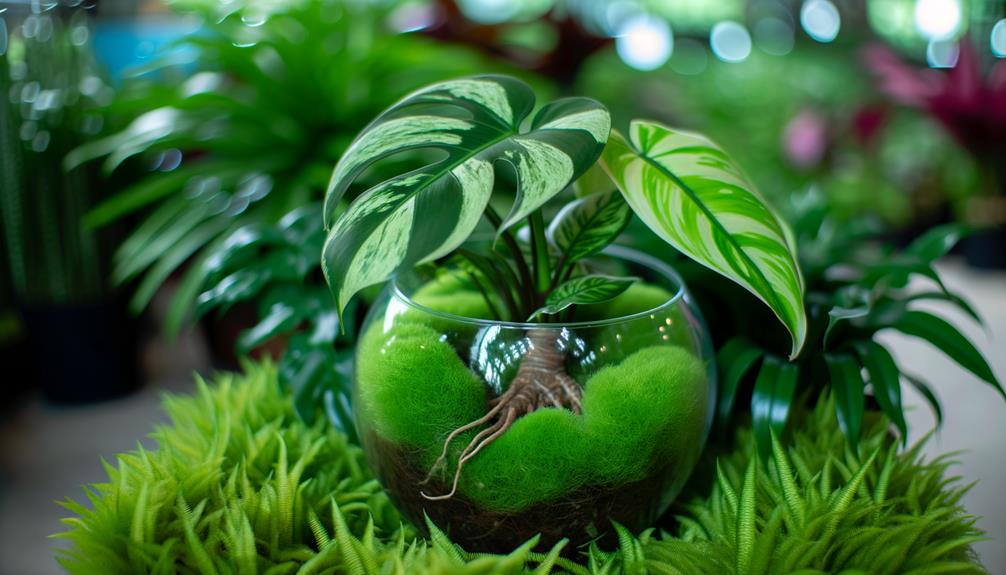
Key Takeaways
- Sphagnum moss helps prevent root rot and supports nutrient absorption for Monstera Albo.
- Ensure the moss is clean, sterile, and from a reliable source before use.
- Use a pot with drainage holes and breathable material like terracotta.
- Maintain temperatures between 65°F and 80°F for optimal growth and variegation.
- Monitor light levels and adjust based on seasonal changes to support year-round growth.
Benefits of Sphagnum Moss

Sphagnum moss frequently provides an excellent environment for Monstera Albo due to its outstanding water retention and aeration properties. You'll find that sphagnum moss can hold up to 20 times its weight in water, ensuring consistent moisture levels for the plant's roots.
This characteristic is vital for Monstera Albo, which thrives in humid conditions. In addition, sphagnum moss's structure allows for superior aeration, preventing root rot by ensuring adequate oxygen flow. Additionally, the moss's slightly acidic pH helps in nutrient absorption, promoting healthier growth.
It's also sterile, reducing the risk of fungal and bacterial infections. By using sphagnum moss, you enhance the root environment, balancing moisture, aeration, and nutrient uptake for your Monstera Albo's best health.
Choosing Quality Sphagnum Moss
You must prioritize moss purity to prevent contaminants from harming your Monstera Albo.
Assess the moisture retention capability to maintain ideal hydration levels for the plant.
Sourcing from reliable suppliers guarantees consistent quality and performance.
Moss Purity Importance
Choosing high-quality sphagnum moss is crucial for guaranteeing the best growth conditions for your Monstera Albo. High-purity moss minimizes the risk of contaminants, such as pathogens or unwanted organisms, which can negatively impact plant health.
When selecting sphagnum moss, carefully examine its source and processing methods. Opt for moss that's been thoroughly cleaned and sterilized to eliminate any potential threats. Additionally, pure sphagnum moss ensures ideal nutrient delivery, essential for the Monstera Albo's development.
Contaminant-free moss also maintains the correct pH level, important for nutrient uptake. Avoid moss mixed with additives or fillers, as these can disturb the delicate balance required for thriving plants.
Prioritizing moss purity ultimately results in healthier, more resilient Monstera Albo specimens.
Moisture Retention Capability
Securing high-quality moss isn't the only factor; its moisture retention capacity is equally essential for the best growth of your Monstera Albo. High-grade sphagnum moss excels in holding water, providing a consistent moisture level vital for root development.
Evaluate the moss's water retention by checking its springiness and the uniformity of water distribution. Optimum sphagnum moss should display high absorbency and minimal decomposition. When hydrated, it should feel soft and flexible without breaking apart easily.
Additionally, ensure it maintains aeration properties, preventing root rot and enhancing oxygen flow. Regularly monitor the moisture levels to adjust as needed, preventing both excessive watering and dehydration. This balance fosters an ideal environment for your Monstera Albo.
Sourcing Reliable Suppliers
Identifying reputable suppliers is crucial to obtaining high-quality sphagnum moss for best Monstera Albo growth. Start by researching suppliers' credibility through reviews and ratings. Prioritize those with consistent positive feedback on product quality.
Verify the origin of the sphagnum moss; New Zealand and Chilean sources are renowned for superior quality. Confirm the moss is sustainably harvested to support environmental standards. Request detailed product specifications, including moisture content, fiber length, and cleanliness to ensure prime conditions for your Monstera Albo.
Compare pricing across different suppliers, but don't compromise quality for cost. Establish direct communication with suppliers to clarify any concerns. Consistently monitor the products received to maintain high standards. This analytical approach guarantees you select the finest sphagnum moss available.
Preparing the Moss
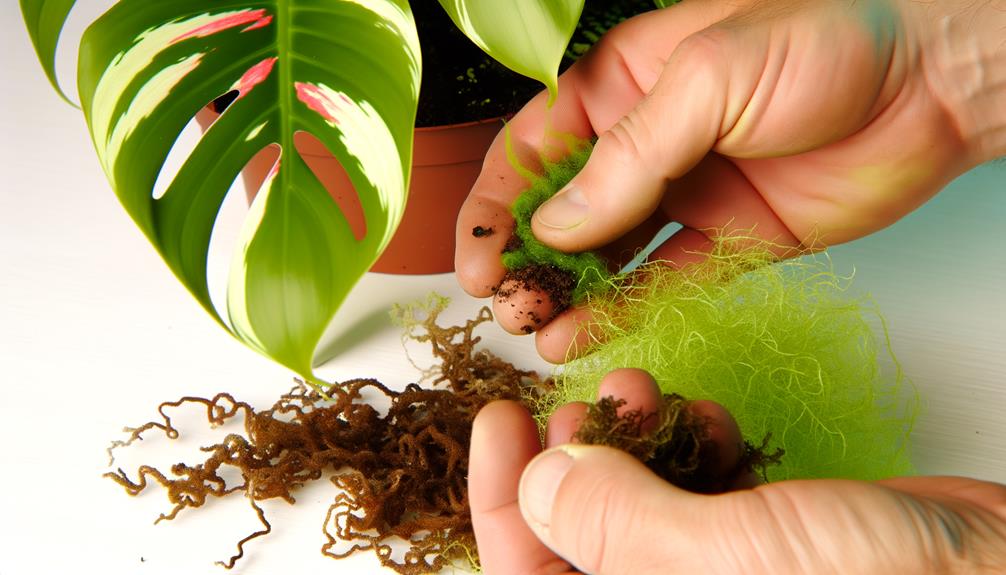
Start by completely hydrating the sphagnum moss to secure it retains sufficient moisture for the Monstera Albo's roots. Immerse the moss in water for about 30 minutes, making sure it is thoroughly saturated. After soaking, gently squeeze out excess water until the moss is damp but not dripping. This step is critical for maintaining peak humidity levels around the root system, promoting healthy growth.
| Step | Description | Outcome |
|---|---|---|
| Soaking | Submerge moss for 30 minutes | Fully saturated moss |
| Squeezing | Remove excess water | Damp, non-dripping moss |
| Readiness | Moss consistency check | Optimal moisture content |
Accurate preparation of the sphagnum moss secures a conducive environment for the Monstera Albo's delicate roots, fostering robust development.
Pot Selection and Preparation
With the moss properly prepared, choose a pot that ensures proper drainage and provides ample space for the Monstera Albo's root system to expand. Select a container with drainage holes to prevent waterlogging, which can lead to root rot. A pot made of breathable material like terracotta facilitates ideal aeration.
Make sure the pot's diameter is at least two inches wider than the root ball, allowing space for growth. Before transplanting, sterilize the pot to eliminate any pathogens. Layer the bottom with coarse material, such as gravel or broken pottery, to improve drainage efficiency.
Place the sphagnum moss evenly around the root ball, ensuring the roots are well-supported. This detailed preparation promotes a healthy environment for your Monstera Albo.
Planting Monstera Albo
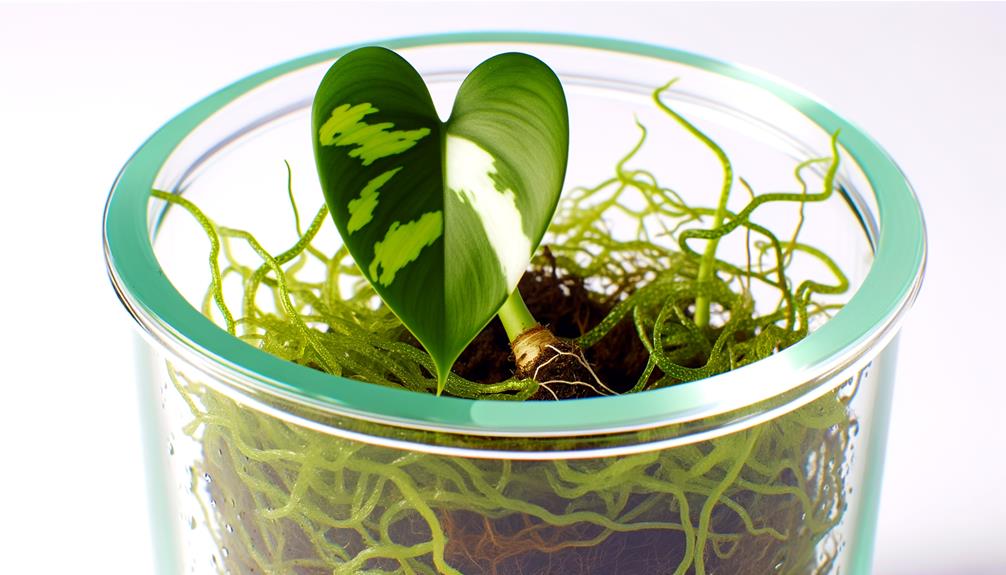
Gently extract the Monstera Albo from its current container, making sure you don't harm the roots in the process. Examine the roots carefully, trimming any that appear dead or unhealthy.
Prepare a new pot with a drainage hole, and fill it one-third full with pre-moistened sphagnum moss. Place the Monstera Albo in the center of the pot, spreading the roots evenly over the moss.
Gradually add more sphagnum moss around the roots, pressing gently to eliminate air pockets and ensure stability. Avoid packing the moss too tightly, as this can hinder root growth.
Once secured, check that the plant is upright and well-supported. Your Monstera Albo is now properly planted in sphagnum moss.
Watering and Humidity Tips
How can you ensure ideal watering and humidity levels to promote the healthy growth of your Monstera Albo in sphagnum moss? First, maintain the moss consistently moist but not saturated. Check moisture levels by feeling the moss; it should be damp to the touch, not dripping. Use distilled or rainwater to avoid mineral buildup.
Monitoring humidity is important. Aim for 60-80% relative humidity. Utilize a hygrometer for precise readings and a humidifier if necessary. Regular misting can also help maintain humidity.
Here's a quick reference table:
| Watering Frequency | Humidity Level | Tools Needed |
|---|---|---|
| Weekly | 60-80% RH | Hygrometer, Humidifier |
| Moist Check | Damp, not soaked | Distilled/Rainwater |
| Misting | Daily | Spray Bottle |
These practices will support optimal growth.
Light and Temperature Requirements
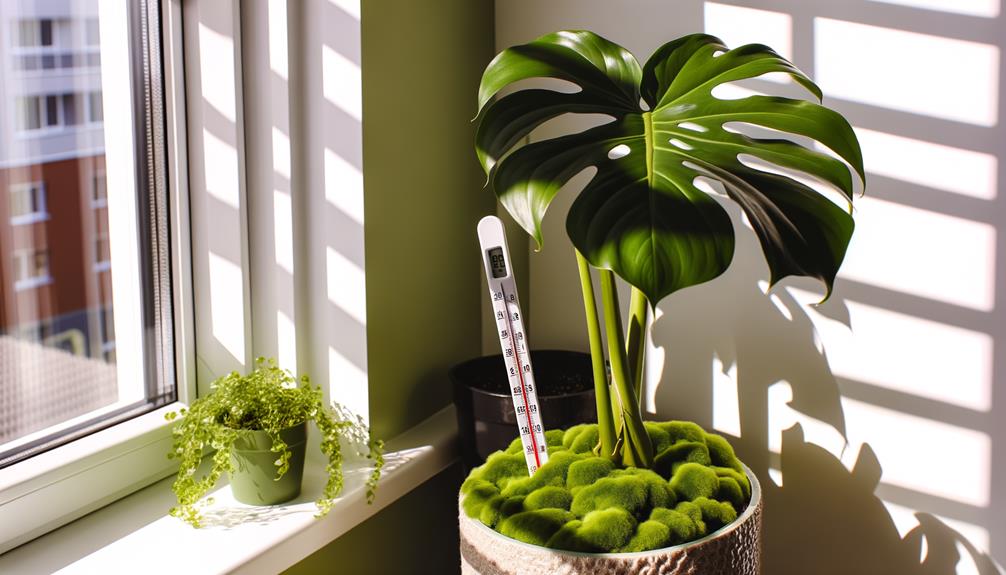
You'll need to guarantee your Monstera Albo receives bright, indirect light to thrive.
Maintain a temperature range between 65-80°F, as fluctuations outside this range can stress the plant.
Additionally, adjust light exposure and temperature settings seasonally to accommodate changes in natural light and indoor climate.
Ideal Light Conditions
Monstera Albo thrives best under bright, indirect light and maintains peak growth when temperatures are consistently between 65°F and 80°F.
You should avoid direct sunlight, as it can scorch the leaves and inhibit photosynthesis. Instead, place your Monstera Albo near an east or north-facing window where it can receive diffused light. If natural light is insufficient, consider using grow lights with a spectrum that mimics daylight.
Monitor light intensity with a light meter to ensure ideal exposure, ideally between 2000 and 4000 foot-candles. Consistent light levels stabilize the plant's metabolic processes, fostering robust growth and variegation.
Temperature Tolerance Range
Maintaining ideal temperature conditions between 65°F and 80°F is vital to guarantee the Monstera Albo's health and growth, as temperatures outside this range can hinder cellular functions and reduce variegation quality. You should monitor ambient temperature closely, ensuring consistency to avoid stress on the plant.
Rapid temperature fluctuations may cause physiological stress, leading to stunted growth or leaf damage.
To optimize temperature conditions, consider these actions:
- Use a digital thermostat to maintain a stable environment.
- Place the plant away from drafts or direct heat sources to prevent temperature swings.
- Utilize a hygrometer to monitor humidity levels, as temperature and humidity are interdependent.
Seasonal Adjustments Needed
Adapting light and temperature conditions for your Monstera Albo throughout the year is essential to accommodate seasonal changes and promote ideal growth. During summer, make sure the plant receives bright, indirect light and maintain temperatures between 65°F and 80°F. In winter, reduce light exposure slightly and keep temperatures no lower than 60°F. You should also avoid significant temperature fluctuations as they can stress the plant.
| Season | Light Exposure | Temperature Range |
|---|---|---|
| Summer | Bright, indirect light | 65°F – 80°F |
| Winter | Moderate, indirect light | 60°F – 70°F |
| Spring/Fall | Bright, indirect light | 65°F – 75°F |
Monitoring these parameters helps in sustaining optimal physiological processes, ensuring your Monstera Albo thrives year-round.
Troubleshooting Common Issues
Identifying and resolving issues with Monstera Albo in sphagnum moss involves recognizing signs of overwatering, under-watering, and pest infestations. Overwatering manifests as yellowing leaves and root rot, while under-watering leads to dry, crispy foliage. Pest infestations, such as spider mites, appear as small, discolored spots on the leaves.
To troubleshoot these issues, follow these steps:
- Check moisture levels: Confirm the sphagnum moss is consistently moist but not waterlogged.
- Inspect roots and leaves: Look for signs of rot or pests, and trim damaged areas.
- Adjust watering schedule: Modify your watering routine based on seasonal changes and plant needs.
Conclusion
Think of caring for your Monstera Albo in sphagnum moss like maintaining a high-performance engine. Just as quality fuel guarantees peak performance, premium sphagnum moss provides the perfect medium for your plant's roots.
Regularly check moisture levels and adjust lighting to keep your Monstera thriving. Remember, even the best engines need fine-tuning—observe your plant closely and address issues promptly.
With attention and precision, you'll enjoy a healthy, vibrant Monstera Albo in no time.



